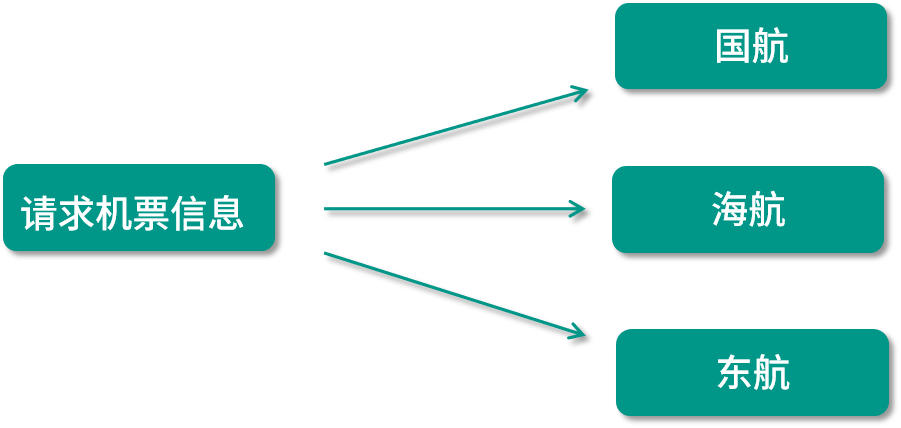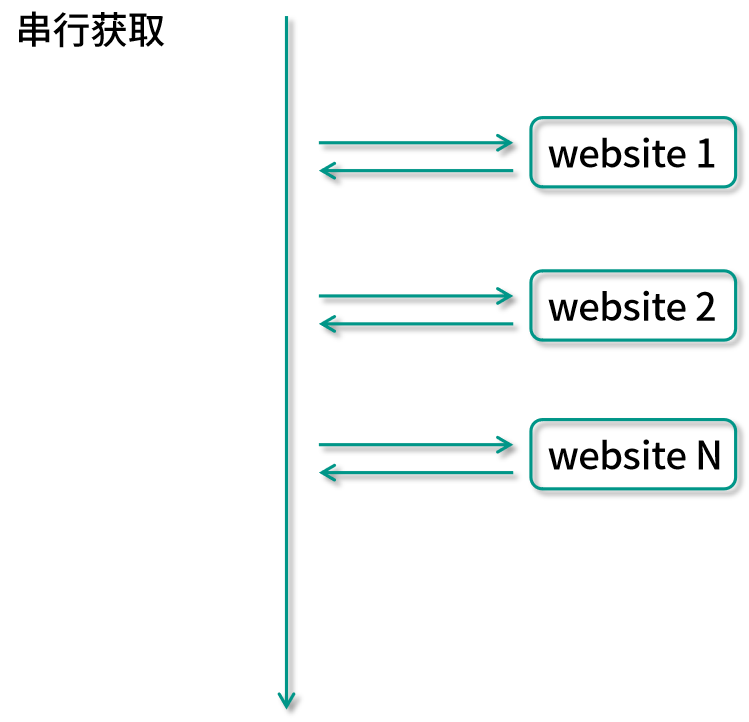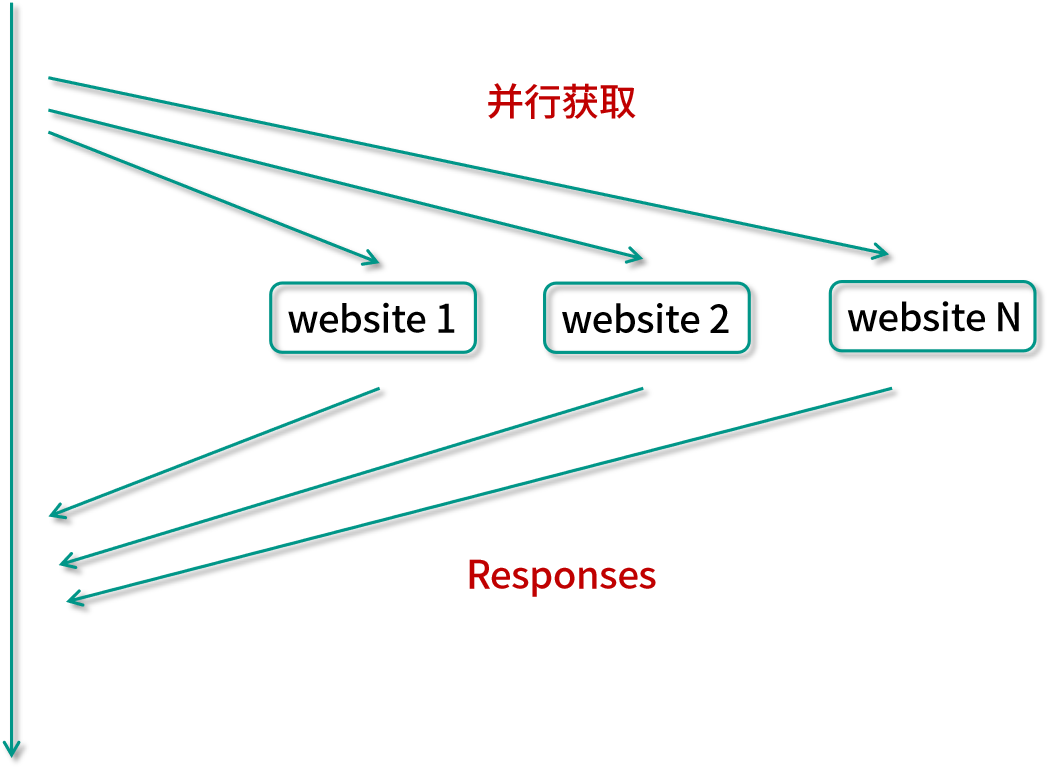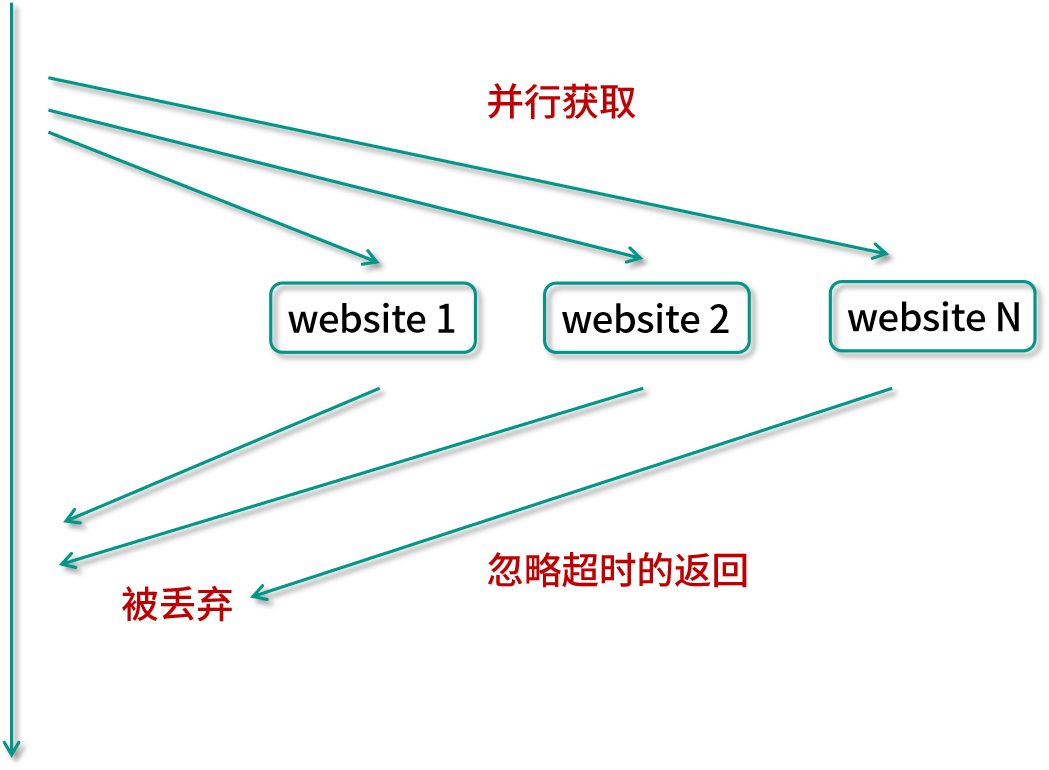51 如何利用 CompletableFuture 实现“旅游平台”问题? 本课时我们主要讲解如何利用 CompletableFuture 实现旅游平台问题。
旅游平台问题 什么是旅游平台问题呢?如果想要搭建一个旅游平台,经常会有这样的需求,那就是用户想同时获取多家航空公司的航班信息。比如,从北京到上海的机票钱是多少?有很多家航空公司都有这样的航班信息,所以应该把所有航空公司的航班、票价等信息都获取到,然后再聚合。由于每个航空公司都有自己的服务器,所以分别去请求它们的服务器就可以了,比如请求国航、海航、东航等,如下图所示:
串行 一种比较原始的方式是用串行的方式来解决这个问题。
比如我们想获取价格,要先去访问国航,在这里叫作 website 1,然后再去访问海航 website 2,以此类推。当每一个请求发出去之后,等它响应回来以后,我们才能去请求下一个网站,这就是串行的方式。
这样做的效率非常低下,比如航空公司比较多,假设每个航空公司都需要 1 秒钟的话,那么用户肯定等不及,所以这种方式是不可取的。
并行 接下来我们就对刚才的思路进行改进,最主要的思路就是把串行改成并行,如下图所示:
我们可以并行地去获取这些机票信息,然后再把机票信息给聚合起来,这样的话,效率会成倍的提高。
这种并行虽然提高了效率,但也有一个缺点,那就是会“一直等到所有请求都返回”。如果有一个网站特别慢,那么你不应该被那个网站拖累,比如说某个网站打开需要二十秒,那肯定是等不了这么长时间的,所以我们需要一个功能,那就是有超时的获取。
有超时的并行获取 下面我们就来看看下面这种有超时的并行获取的情况。
在这种情况下,就属于有超时的并行获取,同样也在并行的去请求各个网站信息。但是我们规定了一个时间的超时,比如 3 秒钟,那么到 3 秒钟的时候如果都已经返回了那当然最好,把它们收集起来即可;但是如果还有些网站没能及时返回,我们就把这些请求给忽略掉,这样一来用户体验就比较好了,它最多只需要等固定的 3 秒钟就能拿到信息,虽然拿到的可能不是最全的,但是总比一直等更好。
想要实现这个目标有几种实现方案,我们一个一个的来看看。
线程池的实现 第一个实现方案是用线程池,我们来看一下代码。
1 2 3 4 5 6 7 8 9 10 11 12 13 14 15 16 17 18 19 20 21 22 23 24 25 26 27 28 29 30 31 32 33 34 35 36 37 38 39 40 41 42 43 44 45 46 47 48 49 50 51 52 53 54 55 56 57 58 59 60 61 62 63 64 65 66 67 68 69 70 71 72 73 74 75 76 77 78 79 80 81 82 83 84 85 86 87 88 89 90 91 92 93 94 95 96 97 98 99 100 101 102 103 104 105 106 107 108 109 110 111 112 113 114 115 116 117 118 119 120 121 122 123 124 125 126 127 128 129 130 131 132 133 public class ThreadPoolDemo { ExecutorService threadPool = Executors.newFixedThreadPool(3); public static void main(String[] args) throws InterruptedException { ThreadPoolDemo threadPoolDemo = new ThreadPoolDemo(); System.out.println(threadPoolDemo.getPrices()); } private Set<Integer> getPrices() throws InterruptedException { Set<Integer> prices = Collections.synchronizedSet(new HashSet<Integer>()); threadPool.submit(new Task(123, prices)); threadPool.submit(new Task(456, prices)); threadPool.submit(new Task(789, prices)); Thread.sleep(3000); return prices; } private class Task implements Runnable { Integer productId; Set<Integer> prices; public Task(Integer productId, Set<Integer> prices) { this.productId = productId; this.prices = prices; } @Override public void run() { int price=0; try { Thread.sleep((long) (Math.random() * 4000)); price= (int) (Math.random() * 4000); } catch (InterruptedException e) { e.printStackTrace(); } prices.add(price); } } }
在代码中,新建了一个线程安全的 Set,它是用来存储各个价格信息的,把它命名为 Prices,然后往线程池中去放任务。线程池是在类的最开始时创建的,是一个固定 3 线程的线程池。而这个任务在下方的 Task 类中进行了描述,在这个 Task 中我们看到有 run 方法,在该方法里面,我们用一个随机的时间去模拟各个航空网站的响应时间,然后再去返回一个随机的价格来表示票价,最后把这个票价放到 Set 中。这就是我们 run 方法所做的事情。
再回到 getPrices 函数中,我们新建了三个任务,productId 分别是 123、456、789,这里的 productId 并不重要,因为我们返回的价格是随机的,为了实现超时等待的功能,在这里调用了 Thread 的 sleep 方法来休眠 3 秒钟,这样做的话,它就会在这里等待 3 秒,之后直接返回 prices。
此时,如果前面响应速度快的话,prices 里面最多会有三个值,但是如果每一个响应时间都很慢,那么可能 prices 里面一个值都没有。不论你有多少个,它都会在休眠结束之后,也就是执行完 Thread 的 sleep 之后直接把 prices 返回,并且最终在 main 函数中把这个结果给打印出来。
我们来看一下可能的执行结果,一种可能性就是有 3 个值,即 [3815, 3609, 3819](数字是随机的);有可能是 1 个 [3496]、或 2 个 [1701, 2730],如果每一个响应速度都特别慢,可能一个值都没有。
这就是用线程池去实现的最基础的方案。
CountDownLatch 在这里会有一个优化的空间,比如说网络特别好时,每个航空公司响应速度都特别快,你根本不需要等三秒,有的航空公司可能几百毫秒就返回了,那么我们也不应该让用户等 3 秒。所以需要进行一下这样的改进,看下面这段代码:
1 2 3 4 5 6 7 8 9 10 11 12 13 14 15 16 17 18 19 20 21 22 23 24 25 26 27 28 29 30 31 32 33 34 35 36 37 38 39 40 41 42 43 44 45 46 47 48 49 50 51 52 53 54 55 56 57 58 59 60 61 62 63 64 65 66 67 68 69 70 71 72 73 74 75 76 77 78 79 80 81 82 83 84 85 86 87 88 89 90 91 92 93 94 95 96 97 98 99 100 101 102 103 104 105 106 107 108 109 110 111 112 113 114 115 116 117 118 119 120 121 122 123 124 125 126 127 128 129 130 131 132 133 134 135 136 137 138 139 140 141 142 143 144 145 146 147 148 149 150 151 152 153 public class CountDownLatchDemo { ExecutorService threadPool = Executors.newFixedThreadPool(3); public static void main(String[] args) throws InterruptedException { CountDownLatchDemo countDownLatchDemo = new CountDownLatchDemo(); System.out.println(countDownLatchDemo.getPrices()); } private Set<Integer> getPrices() throws InterruptedException { Set<Integer> prices = Collections.synchronizedSet(new HashSet<Integer>()); CountDownLatch countDownLatch = new CountDownLatch(3); threadPool.submit(new Task(123, prices, countDownLatch)); threadPool.submit(new Task(456, prices, countDownLatch)); threadPool.submit(new Task(789, prices, countDownLatch)); countDownLatch.await(3, TimeUnit.SECONDS); return prices; } private class Task implements Runnable { Integer productId; Set<Integer> prices; CountDownLatch countDownLatch; public Task(Integer productId, Set<Integer> prices, CountDownLatch countDownLatch) { this.productId = productId; this.prices = prices; this.countDownLatch = countDownLatch; } @Override public void run() { int price = 0; try { Thread.sleep((long) (Math.random() * 4000)); price = (int) (Math.random() * 4000); } catch (InterruptedException e) { e.printStackTrace(); } prices.add(price); countDownLatch.countDown(); } } }
这段代码使用 CountDownLatch 实现了这个功能,整体思路和之前是一致的,不同点在于我们新增了一个 CountDownLatch,并且把它传入到了 Task 中。在 Task 中,获取完机票信息并且把它添加到 Set 之后,会调用 countDown 方法,相当于把计数减 1。
这样一来,在执行 countDownLatch.await(3, TimeUnit.SECONDS) 这个函数进行等待时,如果三个任务都非常快速地执行完毕了,那么三个线程都已经执行了 countDown 方法,那么这个 await 方法就会立刻返回,不需要傻等到 3 秒钟。
如果有一个请求特别慢,相当于有一个线程没有执行 countDown 方法,来不及在 3 秒钟之内执行完毕,那么这个带超时参数的 await 方法也会在 3 秒钟到了以后,及时地放弃这一次等待,于是就把 prices 给返回了。所以这样一来,我们就利用 CountDownLatch 实现了这个需求,也就是说我们最多等 3 秒钟,但如果在 3 秒之内全都返回了,我们也可以快速地去返回,不会傻等,提高了效率。
CompletableFuture 我们再来看一下用 CompletableFuture 来实现这个功能的用法,代码如下所示:
1 2 3 4 5 6 7 8 9 10 11 12 13 14 15 16 17 18 19 20 21 22 23 24 25 26 27 28 29 30 31 32 33 34 35 36 37 38 39 40 41 42 43 44 45 46 47 48 49 50 51 52 53 54 55 56 57 58 59 60 61 62 63 64 65 66 67 68 69 70 71 72 73 74 75 76 77 78 79 80 81 82 83 84 85 86 87 88 89 90 91 92 93 94 95 96 97 98 99 100 101 102 103 104 105 106 107 108 109 110 111 112 113 114 115 116 117 118 119 120 121 122 123 124 125 126 127 128 129 130 131 132 133 134 135 136 137 138 139 140 141 142 143 144 145 146 147 148 149 150 151 152 153 154 155 156 157 public class CompletableFutureDemo { public static void main(String[] args) throws Exception { CompletableFutureDemo completableFutureDemo = new CompletableFutureDemo(); System.out.println(completableFutureDemo.getPrices()); } private Set<Integer> getPrices() { Set<Integer> prices = Collections.synchronizedSet(new HashSet<Integer>()); CompletableFuture<Void> task1 = CompletableFuture.runAsync(new Task(123, prices)); CompletableFuture<Void> task2 = CompletableFuture.runAsync(new Task(456, prices)); CompletableFuture<Void> task3 = CompletableFuture.runAsync(new Task(789, prices)); CompletableFuture<Void> allTasks = CompletableFuture.allOf(task1, task2, task3); try { allTasks.get(3, TimeUnit.SECONDS); } catch (InterruptedException e) { } catch (ExecutionException e) { } catch (TimeoutException e) { } return prices; } private class Task implements Runnable { Integer productId; Set<Integer> prices; public Task(Integer productId, Set<Integer> prices) { this.productId = productId; this.prices = prices; } @Override public void run() { int price = 0; try { Thread.sleep((long) (Math.random() * 4000)); price = (int) (Math.random() * 4000); } catch (InterruptedException e) { e.printStackTrace(); } prices.add(price); } } }
这里我们不再使用线程池了,我们看到 getPrices 方法,在这个方法中,我们用了 CompletableFuture 的 runAsync 方法,这个方法会异步的去执行任务。
我们有三个任务,并且在执行这个代码之后会分别返回一个 CompletableFuture 对象,我们把它们命名为 task 1、task 2、task 3,然后执行 CompletableFuture 的 allOf 方法,并且把 task 1、task 2、task 3 传入。这个方法的作用是把多个 task 汇总,然后可以根据需要去获取到传入参数的这些 task 的返回结果,或者等待它们都执行完毕等。我们就把这个返回值叫作 allTasks,并且在下面调用它的带超时时间的 get 方法,同时传入 3 秒钟的超时参数。
这样一来它的效果就是,如果在 3 秒钟之内这 3 个任务都可以顺利返回,也就是这个任务包括的那三个任务,每一个都执行完毕的话,则这个 get 方法就可以及时正常返回,并且往下执行,相当于执行到 return prices。在下面的这个 Task 的 run 方法中,该方法如果执行完毕的话,对于 CompletableFuture 而言就意味着这个任务结束,它是以这个作为标记来判断任务是不是执行完毕的。但是如果有某一个任务没能来得及在 3 秒钟之内返回,那么这个带超时参数的 get 方法便会抛出 TimeoutException 异常,同样会被我们给 catch 住。这样一来它就实现了这样的效果:会尝试等待所有的任务完成,但是最多只会等 3 秒钟,在此之间,如及时完成则及时返回。那么所以我们利用 CompletableFuture,同样也可以解决旅游平台的问题。它的运行结果也和之前是一样的,有多种可能性。
最后做一下总结。在本课时中,我们先给出了一个旅游平台问题,它需要获取各航空公司的机票信息,随后进行了代码演进,从串行到并行,再到有超时的并行,最后到不仅有超时的并行,而且如果大家速度都很快,那么也不需要一直等到超时时间到,我们进行了这样的一步一步的迭代。
当然除了这几种实现方案之外,还会有其他的实现方案,你能想到哪些实现方案呢?不妨在下方留言告诉我,谢谢。



